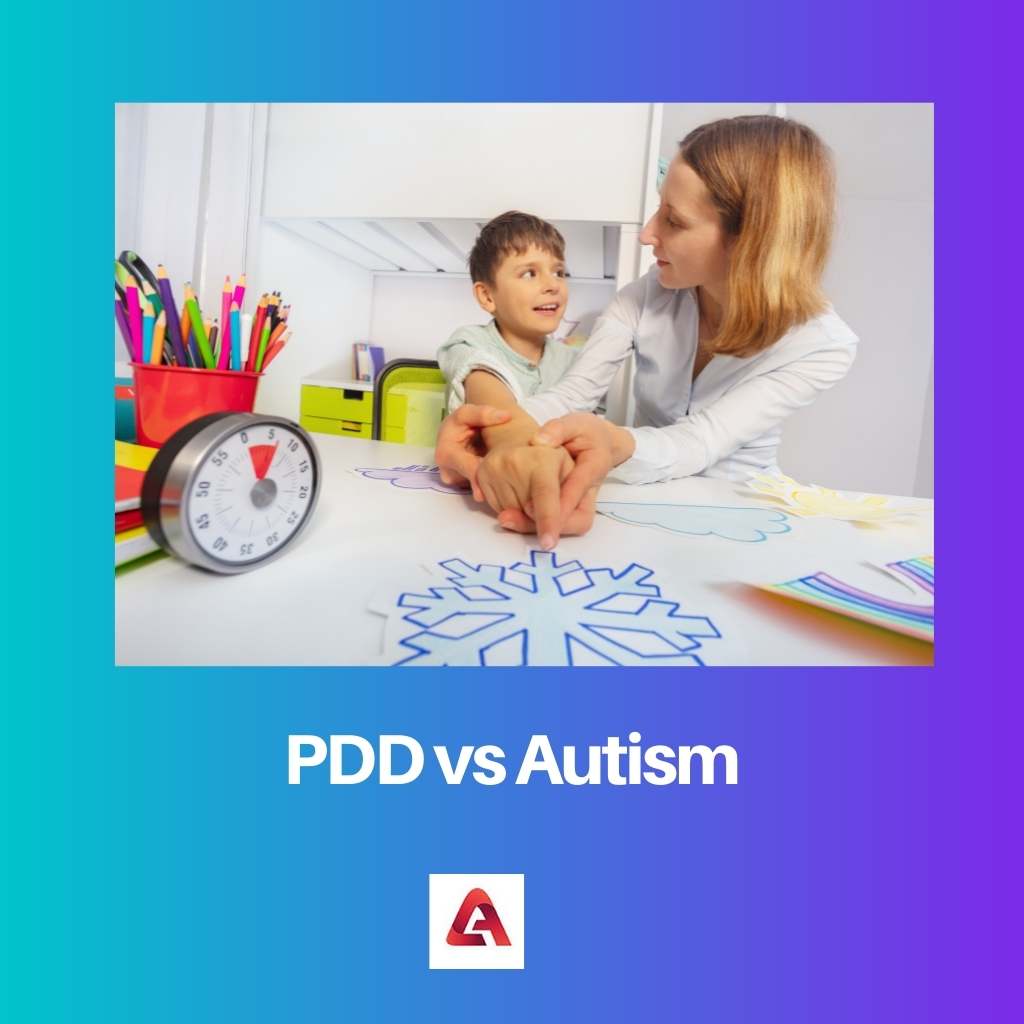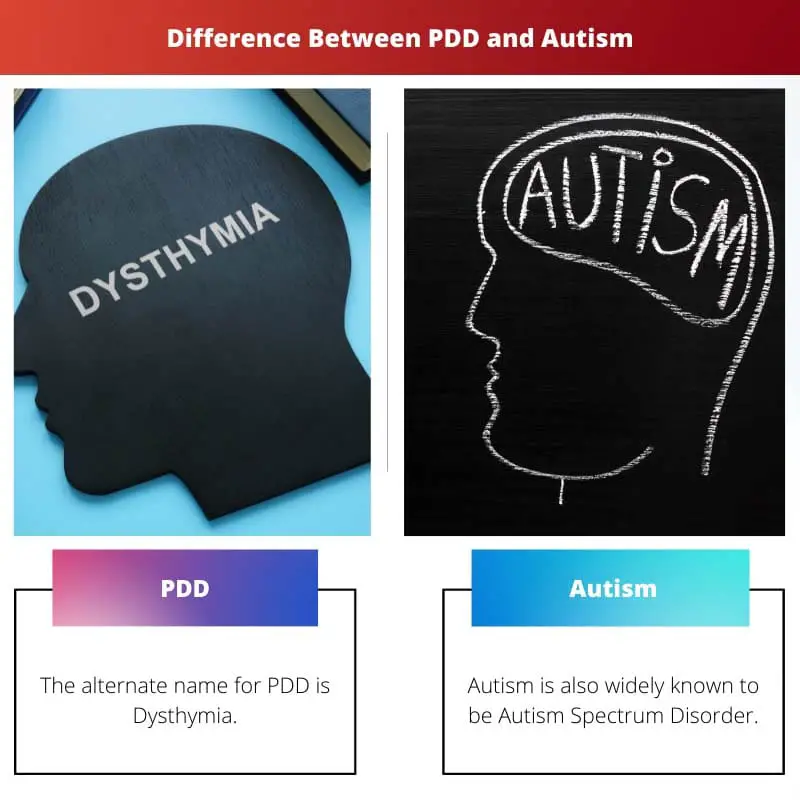It has been noticed that there has been a sudden rise in the rate of mental disorders. Generally, the disorders happen to be in a child since birth, or it gradually starts developing after birth.
It is still a question as to how the disorders have been increasing. And some common disorders are autism, epilepsy, learning disorders, PDD, etc. Here, we will talk about PDD and Autism.
Key Takeaways
- PDD (Pervasive Developmental Disorder) is an umbrella term encompassing several developmental disorders, including autism.
- Autism is a neurodevelopmental disorder characterized by social and communication challenges, repetitive behaviors, and restricted interests.
- Early intervention is crucial for both PDD and autism, with tailored treatment plans including behavioral therapy, speech therapy, and occupational therapy.
PDD vs Autism
PDD (Pervasive Developmental Disorder) is a larger category that encompasses social interaction, communication, and behavior issues including Autism. Autism is a specific disorder marked by repetitive behaviors, difficulties with social interaction, and communication difficulties.

PDD is the abbreviation for the terms Pervasive Development Disorder.
The diagnosis of such disorder is characterized by some other specific disorders, which include autism, Rett Syndrome, Asperger’s Syndrome, Childhood Disintegrative Disorder, and last but not least, PPD-NOS (PPD- Not Other Specified).
On the other hand, Autism is one of the serious health conditions among infants. Autism is detected at a very early age.
Here, the child has to go through various challenges, both mentally as well as physically. And this includes things such as a lack of social skills, depression, poor communication skills, etc.
Comparison Table
| Parameters of Comparison | PDD | Autism |
|---|---|---|
| Alternate Name | The alternate name for PDD is Dysthymia. | Autism is also widely known to be Autism Spectrum Disorder. |
| Specialist | The best Specialists for PDD are Primary Care Provider (PCP), Clinical Psychologists, and Psychiatrists. | Several Specialists look up to Autism and it includes Child Psychiatrist, Pediatric Neurologist, and Developmental Pediatrician. |
| Age Of Diagnosis | Around 15 months to 3-year-old children are seen diagnosed with PDD. | Generally, Autism has been traced between children aged 2-3 years and it stays a lifetime. |
| Symptoms | When a child is diagnosed with PDD, we can notice some strange and unusual behavior in the child such as bad communication skills, problems while transitions, poor language skills, etc, and these are the symptoms of PDD. | There are various symptoms of Autism and that includes delayed language skills, delayed movement, mood swings, crying, violence, etc. |
What is PDD?
PDD is a common disorder that is seen in children. This disorder comes along since the child’s birth, but its main diagnosis is determined after a few months when the child starts developing itself.
PDD refers to Pervasive Development Disorder. It is also also known to many people as Dysthymia. PDD is determined in a child when their parents start feeling some unusual behavior or actions done by the child.
Mainly the child lacks communication skills, poor language, aggressiveness, sadness, etc. And gradually, these symptoms start to develop more and more.
Majorly, the symptoms are diagnosed in children aged between 15 months to 3 years. It is not a curable disorder, and hence the child has to challenge themselves every single day.
It is considered that there are no specific reasons behind the occurrence of such a disorder, but specialists have assumed that such disorders are caused because of some genetic history/problem, some neurological abnormalities, etc.
The child not only faces problems with communication or language skills, but they also develop certain other complications as well.
And these might include things like depression, anxiety, anti-social behavior, suicidal thoughts, etc. And such complications can be deadly as well.
Hence, the child needs proper care not only from his/her parents, siblings, relatives, etc. but also from medications and therapies as well.
Several therapies have been designed for such special kids to calm themselves mentally.
What is Autism?
Autism is a mental disorder that only affects mental health but also physical health as well. It is also commonly known as Autism Spectrum Disorder.
Here, the child has to deal with many struggles, from communication to behavior. Generally, Autistic children are very friendly, but during their meltdowns, they become very aggressive and start to hit themselves.
Only their near and dear ones, especially their parents, can control them. Such disorders are diagnosed in between children of 2-3 years.
The cause of Autism depends upon some genetic disorder, environmental toxins, low birth weight, etc. But doctors are still unaware of the main root of such diseases.
Children with this disorder find it difficult to process their feelings and hence lacks behind in society. They only need love, care, attention, and some external help, such as therapies.
As we know, autism affects the physical body as well, hence it develops some other complications such as tumors, seizures, bad posture, etc.
Therefore, physiotherapy is also a must since it will keep the child active and fresh. There are also some special schools for the development of basic learning.
Dancing and singing can also play a great role in their lives as well.

Main Differences Between PDD and Autism
- PDD has an alternative name, and that is Dysthymia on the other hand, for many people, Autism is also commonly known as Autism Spectrum Disorder.
- Primary Care Providers (PCP), Clinical Psychologists, and Psychiatrist are some Specialists who deal with PDD, and on the other hand, some Specialists who look after the department of Autism are Child Psychiatrist, Pediatric Neurologists, and Developmental Pediatricians.
- At the early age of 15 months to 3-year-old babies are diagnosed with PDD; on the other hand, the age limit for children diagnosed with Autism is 2 to 3 years old.
- Bad communication skills, problems while transitions, poor language skills, etc., are the common symptoms of PDD. On the other hand, autism is diagnosed very early, and here children are seen with symptoms such as bad communication, delayed movement, mood swings, etc.

- https://link.springer.com/article/10.1007/s10803-009-0723-6
- https://www.sciencedirect.com/science/article/pii/S0890856714000446

The rate of mental disorders in children is increasing at an alarming rate. This is a major concern. More research is needed to address this issue.
The article does a great job of highlighting the symptoms, diagnosis, and impact of PDD and Autism. More emphasis should be put on educating parents, caregivers, and communities about these disorders to ensure that children receive the support they need.
It’s quite concerning to see the rise in mental disorders among children. The article does a thorough job of explaining the key differences between PDD and Autism. More research is needed to identify the causes and develop effective treatment strategies.
The article provides a comprehensive understanding of the differences between PDD and Autism. Early intervention is crucial for both and tailored treatment plans including behavioral therapy, speech therapy, and occupational therapy can help in improving the condition.
This information is invaluable for anyone looking to understand PDD and Autism better. The article provides a detailed overview of the disorders, their symptoms, and the care required. Early diagnosis and intervention can make a significant difference in the lives of affected children.
The comparison table and key takeaways are very informative and provide a clear understanding of the disorders. It’s important to raise awareness about these conditions and ensure that affected children receive proper care and support.